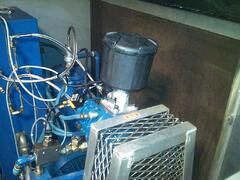Plant air is a known energy sink and you may not think of a shop air compressor as an area that can be made more sustainable. At Aerzen’s LEED certified facility in Coatesville we initially were not able to improve upon old concepts at first either. During the course of the last three years we were able to make significant changes to reduce its environmental impact. Adding an electronic controller, variable speed drive, remote monitoring and recycling waste heat did a fantastic job reducing the carbon foot print of the compressed air system. They are simple ideas that you can implement in one way shape or form. Your bottom line may be affected by this more than you think.

This is a view into the sound enclosure of the Aerzen compressor package.
One improvement that anyone can make right from the time to look for a new compressor system is to choose a continuous duty rotary screw compressor over a conventional piston compressor. The reason is that you have to quite oversize a piston compressor since they typically are not intended to be run continuously. Also, the piston compressor usually requires a higher discharge pressure to make the best use of the two-point pressure control and / or a bigger air tank. Both of the measures contribute to less run time per hour for the piston compressor and yet this uses more energy than a rotary screw compressor that can continuously operate at a lower pressure.
The 15 year old oil flooded single stage Aerzen rotary screw compressor VMXa0937R had initially been designed for a simple 2 point load-unload compressed air system with a single speed belt drive and a 25 horsepower motor. It was set up with a long minimum run time setting and a digital switch and relay type control panel. Throughout most of its life it seemingly operated all day, and it was never shut off after business hours and the weekends. Using an Aerzen AS200 compressor controller we were able to reduce the minimum and after-hour run time. With a so called weekly operating schedule program it was possible to enter the daily time frames where the compressor was expected to be online. This reduced the operating time significantly because even though our company’s compressed air system’s leakage rate is well below the industry benchmark of 10%, it would have still meant for the compressor to run multiple times overnight or the weekend. Ideally, we could install a smaller compressor that would then be able to operate at a better overall efficiency, because it would operate at a higher RPM. Running a bigger compressor than necessary at a low speed causes for the motor and compressor to run at lower electric and volumetric efficiency.
The next thing we installed was an Aerzen iAir Remote Control monitoring system. This is a system that connects to the controller via industrial cell phone technology and is connected to the central server allowing accessing and trending of the compressor operating parameters. We found out that the compressor capacity was much larger than practical. This led to the installation of a constant speed – constant torque variable speed drive. We were able to reduce the speed to about ½ from max speed and were still able to maintain and never drop below nominal system pressure. This offered a phenomenal power reduction.
In the final step we thought that we could make use of the heat energy that comes off of the oil cooling system. An oil flooded rotary screw compressor puts the gross majority of the heat stemming from the compression process into the lubricant. This heat is removed by air cooled oil coolers and can present issues with the removal of this heat out of a compressor room. Here we installed one oil cooler with fan in our production area away from the compressor room. This allows us using the heat to help heating the production area in the winter months. By ways of using oil system diverter valves we can also put the hot oil through another cooler that is installed on the outside wall of the building. This makes sure we can operate in the summer without having to cool the compressor room, or to put additional heat into the building.
Please see the link below for the quick video showing the key elements for the upgrades.
Challenge yourself by asking how your compressed air system may be improved upon. There is a large amount of energy potential that is currently wasted and thus pulls straight from your bottom line – the power bill often gets overlooked. Please drop me a note in case you have comments, suggestions or questions.
 Aerzen USA
Aerzen USA
Ralf Weiser
rweiser@aerzenusa.com
